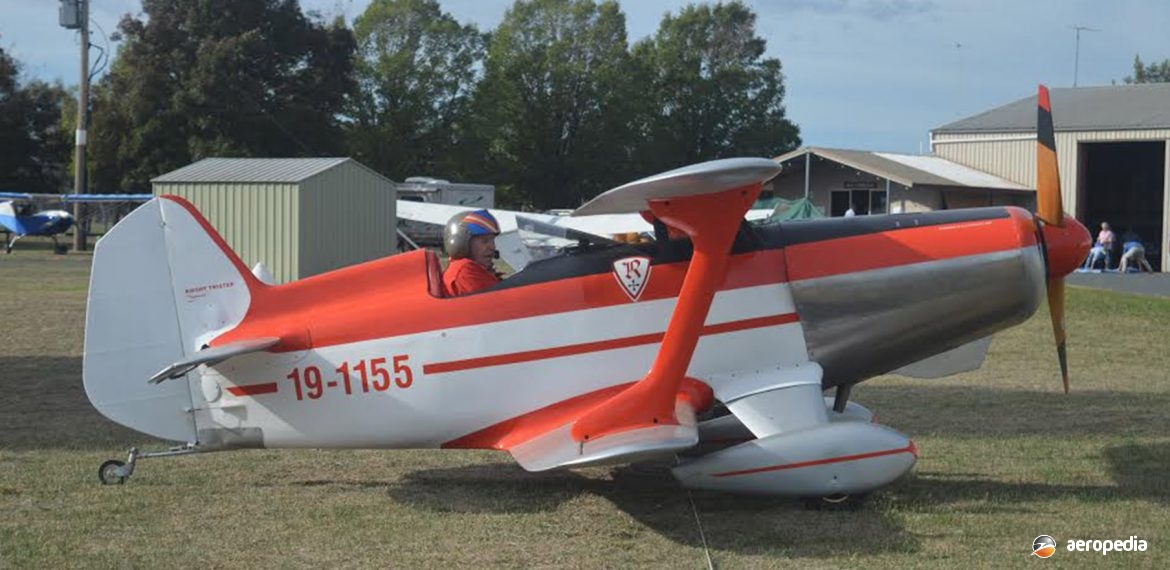Photograph:
Payne Knight Twister 19-1155 (c/n not known) at Holbrook, NSW in April 2019 (P J Ricketts)
Country of origin:
United States of America
Description:
Single-seat light sporting biplane
Power Plant:
One 67 kw (90 hp) Continental C-90 four-cylinder horizontally-opposed air-cooled engine
Specifications:
- Wingspan [upper]: 4.57 m (15 ft); [lower] 3.96 m (13 ft)
- Length: 4.27 m (14 ft)
- Wing area: 5.5 m² (60 sq ft)
- Max speed at sea level: 257 km/h (160 mph)
- Max cruising speed: 225 km/h (140 mph)
- Max rate of climb at sea level: 275 m/min (900 ft/min)
- Range with max fuel: 625 km (390 miles)
- Empty weight: 243 kg (535 lb)
- Loaded weight: 435 kg (960 lb)
History:
The Knight Twister was a single-seat, single-engine, aerobatic sport biplane designed in 1928, built and first flown in 1932 by Vernon W Payne. Since then it has been marketed in plan form for home constructors. The original prototype was known as the KT-85 Knight Twister but various examples have been produced with a variety of engines, including Continental and Lycoming units ranging in power from 63 kw to 108 kw (85 hp to 145 hp). The second prototype was flown with a Salmson 9Ad radial engine but was damaged in a forced landing. Parts were used to build another example fitted with a Ford Model A engine and this was known as the KTD-2, later being redesignated Knight Twister Junior.
One example was built in Illinois in the US with a 134 kw (180 hp) Lycoming O-360 engine. In 1971 Mr Payne modified the design of the tailplane, increasing the span and reducing the chord, the area remaining unchanged. Other variants included the KT-80 with a Franklin engine, the KT-95 with a Lambert engine, KT-Imperial, KT Holiday, and Pretty Prairie Special II and III, the latter having a Menasco engine. Examples of early build aircraft are known to survive in the EAA Museum at Oshkosh, Wisconsin and the Kansas Aviation Museum.
The wings are fully cantilever in design and do not have bracing wires but most builders brace the wings with I-struts and at least one pair of wires. The cockpit is open and the tailwheel undercarriage is of conventional design. The wings and horizontal stabiliser are of wood construction, skinned with plywood, whereas the fuselage and vertical stabiliser are of welded steel tube with fabric covering. The type has been popular in the US, one example flown by Clyde Parsons winning the Sport Biplane Championship at Reno in 1964. Another, flown by Don Fairbanks, set a sport biplane class record for biplanes of 284 km/h (178 mph).
In the 1990s rights to the design were acquired by Steen Aero of Mario, North Carolina. It continues to be offered to home constructors, with the single-seat variant available with 5.33 m (17 ft 6 in) or 5.94 m (19 ft 6 in) wings. More recently a two-seat variant with a 6.85 m (22 ft 5 in) wing became available. At least one example is known to have been completed in Australia. Built by Fritz Knadehase, it became 10-1155 initially but later had the registration changed on 10 January 1995 under Recreation Aviation Australia (RAA) regulations to 19-1155. It was fitted with a Subaru EA-81 engine. It was painted silver with black trim and has been described in records as a Fritz Knadehase Kopykat. It has also been known as the Knight Twister Kopy-Kat and has been based at Bendigo, VIC. In more recent years ownership has changed and it has been painted in a new colour scheme.

